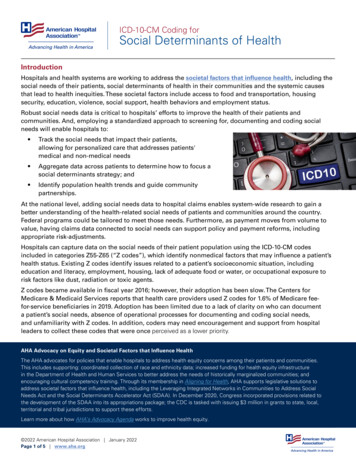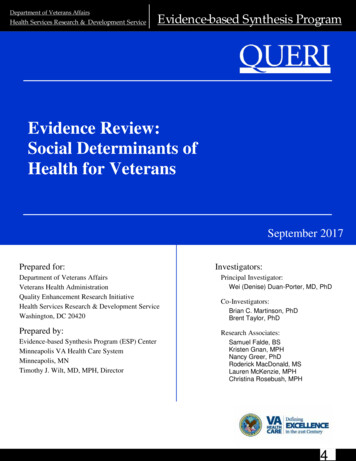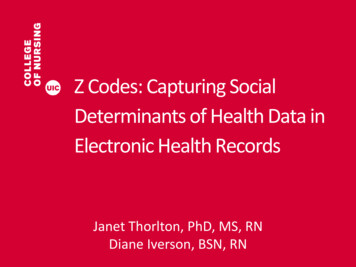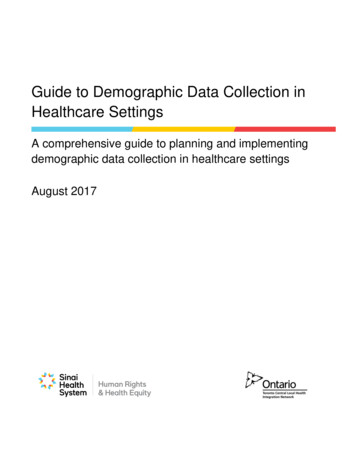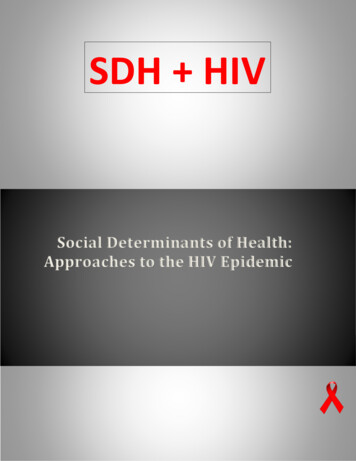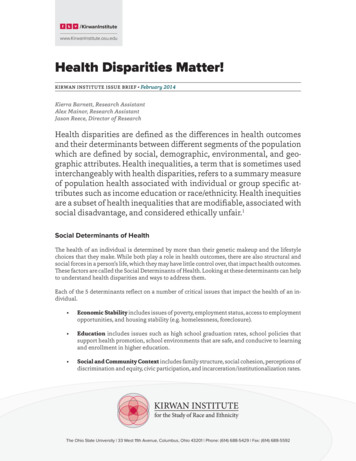
Transcription
/KirwanInstitutewww.KirwanInstitute.osu.eduHealth Disparities Matter!KIRWAN INSTITUTE ISSUE BRIEF February 2014Kierra Barnett, Research AssistantAlex Mainor, Research AssistantJason Reece, Director of ResearchHealth disparities are defined as the differences in health outcomesand their determinants between different segments of the populationwhich are defined by social, demographic, environmental, and geographic attributes. Health inequalities, a term that is sometimes usedinterchangeably with health disparities, refers to a summary measureof population health associated with individual or group specific attributes such as income education or race/ethnicity. Health inequitiesare a subset of health inequalities that are modifiable, associated withsocial disadvantage, and considered ethically unfair.1Social Determinants of HealthThe health of an individual is determined by more than their genetic makeup and the lifestylechoices that they make. While both play a role in health outcomes, there are also structural andsocial forces in a person’s life, which they may have little control over, that impact health outcomes.These factors are called the Social Determinants of Health. Looking at these determinants can helpto understand health disparities and ways to address them.Each of the 5 determinants reflect on a number of critical issues that impact the health of an individual. Economic Stability includes issues of poverty, employment status, access to employmentopportunities, and housing stability (e.g. homelessness, foreclosure). Education includes issues such as high school graduation rates, school policies thatsupport health promotion, school environments that are safe, and conducive to learningand enrollment in higher education. Social and Community Context includes family structure, social cohesion, perceptions ofdiscrimination and equity, civic participation, and incarceration/institutionalization rates.The Ohio State University 33 West 11th Avenue, Columbus, Ohio 43201 Phone: (614) 688-5429 Fax: (614) 688-5592
KIRWAN INSTITUTE ISSUE BRIEF February 20142/6 Health and Health care includes access to both health services and primary care, andthe health technology that is available. Neighborhood and Built Environment includes quality of housing, crime and violence,environmental conditions, and access to healthy foods.Together all of these factors and others impact health outcomes. The inequities that exist withineach of these determinants are what contributes to the growing health disparities that we see today.The U.S. PopulationThe U.S. population is constantly changing. The maps below show the percentageof people who are of color by U.S. counties in 2010 compared to the estimatesfor 2040. Over the next few decades,more counties will become what has beentermed as “majority minority” counties.It has been estimated that by 2040, themajority of the U.S. population will bepeople of color.2As the population continues to change,it becomes more important to focus onhealth disparities in America. Whether isis the direct cost to the health care systemor the indirect cost to productivity in theworkplace, the effects of health disparities on the economy impacts all Americans.The Cost of Health DisparitiesHealth disparities accounted for 1.24trillion in health care cost in the U.S. from2003 to 2006. Nearly 31% of the directmedical care expenditures for AfricanAmerican, Asians, and Hispanics wereattributed solely to the costs of health inequity.3 Specifically, in Ohio, disparitiesin diabetes, hypertension, stroke/renaldiseases and poor general health cost the state 1 billion in health care cost annually.4 Two examples of these cost of disparities can be seen in diabetes and adverse birth outcomes.Example 1: DiabetesIn Ohio, 9.4% of residents have been diagnosed with diabetes. However, the prevalence of the diseaseis higher among minority populations. Nationally, the prevalence of diabetes among African Americans and Hispanics is twice the prevalence among Whites. However, in Ohio, though disparitiesstill exist, the rate of the disparities are not as great as they are at the national level./KirwanInstitute www.KirwanInstitute.osu.edu
3/6KIRWAN INSTITUTE ISSUE BRIEF February 2014The financial cost resulting from diabetes also varies across different races and ethnicities. Thetotal cost per-capita health care expenditures for diabetes are the highest among non-HispanicsBlacks ( 9,540), second highest among non-Hispanic Whites ( 8,101) and lowest among Hispanics ( 5,930).5These disparities not only result in financial cost, lives are also lost due to the existing disparities.In Columbus, the diabetes mortality rate is twice as high as it is for the rest of nation and there aredisparities within the mortality rate. The diabetes mortality rate for African American males, forexample, is 3.5 times that of the general population.6 Without addressing the health disparities,money and lives will continue to be lost.Example 2: Adverse Birth OutcomesAdverse birth outcomes include preterm birth, low birth weight, and the child being small for itsgestational age. These adverse birth outcomes are most prevalent among disadvantaged socioeconomic groups. Roughly half of the women giving birth in the United States are poor or nearpoor. In particular, African-Americans and Hispanics are more likely to live in concentrated areasof poverty. These areas face a number of problems such as poor housing, crime, noise, pollution,stress, and a lack of services, all of which have negative health impacts. 7The cost of adverse birth outcomes is estimated at more than 26.2 billion lost in medical costs, educational costs, and lost productivity in 2005.8 A normal birth without complications costs roughly 8,000, however, a single adverse pregnancy can cost up to 57,000. These adverse birth outcomesare substantially more likely to occur with Medicaid patients than those covered by private insurance (22% vs. 12-13% respectively).9 In Franklin County, the average cost of neo-natal care asa result of an adverse birth outcome is 66,000, with some babies costing in excess of 2 million.These adverse birth outcomes affect minority populations at greater rates than white populations.For example, in Ohio Black infants are twice as likely to die during their first year of life comparedto White infants with rates of infant mortality being 15.2 among black infants and 6.0 among whiteinfants.10 (This rate can be seen in the figure below.) By reducing these disparities, health care costsresulting from adverse birth outcomes can be decreased exponentially./KirwanInstitute www.KirwanInstitute.osu.edu
KIRWAN INSTITUTE ISSUE BRIEF February 20144/6The Health of the People Equals the Stability of the NationNot sure how these health disparities impact your life? Health disparities have an impact onall of us. An increase in the number of Ohioans who are both insured and healthy will lead toan increase in revenue for the state. It is estimated that the Medicaid Expansion under the PatientProtection and Affordable Care Act (ACA, also known as ObamaCare) will create between 23,000and 26,000 jobs in the state of Ohio in health care and in other industries. The expansion in Medicaid is also estimated to increase earning among Ohio residents between 2014 and 2022 by up to 1.75 billion and increase economic activity in that time by up to 19.8 billion.11Eliminating health disparities will also improve the economy by reducing the indirect costs ofillness. These indirect costs include workdays missed due to health conditions, reduced work productivity while at work due to health conditions, reduced workforce participation due to disability, and productivity lost due to premature mortality. For example, the loss of productivity due todiabetes results in 69 billion in costs domestically.12The Medicaid Expansion alone is estimated to save employers in Ohio 1.7 billion by creatinghealthier, more productive workers but the expansion also helps eliminate health disparities byincreasing access to care.13 However the method, eliminating health disparities create a healthierpopulation which will in turn create healthier workers andkeep the United States in a competitive global market.What Can Be DoneAwareness that health disparities exist alone is not enoughto make a difference. It is only the first step. Step two is totake action!Eliminating healthdisparities will also improvethe economy by reducing theindirect costs of illnessHere are some ideas: Become a leader in your organization or community to increase their awareness andknowledge of health disparities. Organize committees and coalitions to decide ways to address health disparities. Supporthealthy and safe behaviors in your community. For example, involve members of your organization in group physical activities or a fitness challenge or adopt initiatives such asMichelle Obama’s Let’s Move! initiative to encourage healthy lifestyles among the youth. Advocate for healthy neighborhood by suggesting the creation of sidewalks, parks, andrecreation centers where disparities are the greatest. Advocate for resources in the community to improve access to healthy foods and accessto quality health care.Eliminating health disparities will take collaborations around the community with members of thecommunity, business owners, public health workers, physicians, and policy makers. These collaborations have to aim at reducing and eventually eliminating disparities that exist among the socialdeterminants of health to effectively address health disparities. By improving equality across thelifespan, health disparities can be eliminated./KirwanInstitute www.KirwanInstitute.osu.edu
5/6KIRWAN INSTITUTE ISSUE BRIEF February 2014References Cited1. Truman, Benedict I., et al (2011). Rationale for Regular Reporting onHealth Disparities and Inequalities- United States. CDC Health Disparities and Inequalities Report.2. Policy Link. (2010). Retrieved from 6035/k.67C/America8217s Tomorrow.htm3. LaVeist, Thomas A., et al. (2009). The Economic Burden of HealthInequalities in the United States. Joint Center for Political and Economic Studies, 1.4. Waidmann, Timothy (2009). Estimating the Cost of Racial and EthnicHealth Disparities, 2. The Urban Institute. Retrieved from http://www.urban.org/publications/411962.html.10. Ohio Department of Health. (2012). Infant Mortality. Women andInfants Health 2012, 2–3.11. Expanding Medicaid in Ohio: Analysis of Likely Effects (2013).Health Policy Institute of Ohio, 16. Retrieved from ions/.12. American Diabetes Association, Economic Costs of Diabetes in2012 (2013). Diabetes Care 36:1033–1046.13. Expanding Medicaid in Ohio: Analysis of Likely Effects (2013).Health Policy Institute of Ohio, 16. Retrieved from ions/5. The Cost of Diabetes. American Diabetes Association. Retrieved t-of-diabetes.html.6. Diabetes in Central Ohio: A Problem We Can’t Afford to Ignore (2013).Central Ohio Diabetes Association. Retrieved from ntralOhio/tabid/142/Default.aspx.7. Blumenshine, Philip, et al. (2010). Socioeconomic Disparities inAdverse Birth Outcomes: A Systematic Review. Am. J. Prev. Med.39(3)263 –272.8. Healthy Beginnings: Collaborating to Change the Numbers on CentralOhio Preterm Births. Ohio Better Birth Outcomes Report (2009). Retrieved from thsoutcomes-report.9. The High Cost of Adverse Birth Outcomes in Medicaid Programs(2012). Viewpoints. Retrieved from cy-2/.Fact sheet authored by Kierra Barnett, Alexander Mainor and Jason Reece. Editingprovided by Kwame Christian. The Kirwan Institute for the Study of Race & Ethnicity. The Ohio State University.Produced in collaboration with the Ohio Health Disparities Collaborative, withsupport from the Ohio Minority Health Commission./KirwanInstitute www.KirwanInstitute.osu.edu
6/6KIRWAN INSTITUTE ISSUE BRIEF February 2014This publication was produced by the Kirwan Institute for the Studyof Race and Ethnicity at The Ohio State University. As a university-wide, interdisciplinary research institute, the Kirwan Instituteworks to deepen understanding of the causes of—and solutions to—racial and ethnic disparities worldwide and to bring about a societythat is fair and just for all people.Kirwan Institute research is designed to be actively used to solveproblems in society. Its research and staff expertise are sharedthrough an extensive network of colleagues and partners—rangingfrom other researchers, grassroots social justice advocates, policymakers, and community leaders nationally and globally, who canquickly put ideas into action.For More InformationThe Kirwan Institute for the Study of Race and Ethnicity at TheOhio State University is known and respected nationally and deeplyengaged in social issues. We are focused on projects that are integrated with sound research, strategic communication, and advocacy. To learn more, visit www.kirwaninstitute.osu.edu.The Ohio State University33 West 11th AvenueColumbus, Ohio 43201Phone: (614) 688-5429Fax: (614) e www.KirwanInstitute.osu.edu
nicity. The Ohio State University. Produced in collaboration with the Ohio Health Disparities Collaborative, with support from the Ohio Minority Health Commission. 10. Ohio Department of Health. (2012). Infant Mortality. Women and Infants Health 2012, 2-3. 11. Expanding Medicaid in Ohio: Analysis of Likely Effects (2013).
